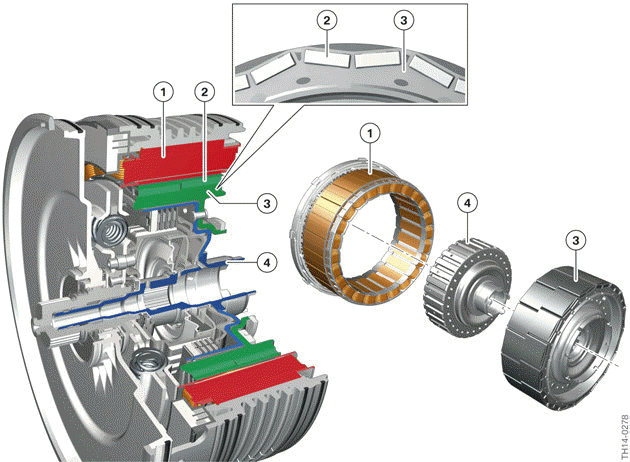BMW 3: Rotor and stator

Rotor and stator, electrical machine
- Stator
- Permanent magnets
- Rotor
- Hollow shaft with outer basket of separation clutch
The electrical machine in the G20 PHEV is structured as an inner rotor. "Inner rotor" means that the rotor is arranged with the permanent magnets arranged in a ring shape on the inside. The coils for generating the rotating field are located on the outside and form the stator. The electrical machine has 8 pole pairs.
The rotor is mounted above a flange on the rotor hollow shaft, which is positively connected to the transmission input shaft.
READ NEXT:
 Connections
Connections
Connections, electrical machine
Transmission bell housing
Temperature sensor
Coolant ducts
Connection for coolant (transmission oil)
Electrical connection, rotor position sensor
High-voltage c
 Sensors
Sensors
Sensors, electrical machine
Temperature sensor
Rotor of the rotor position sensor
Stator of the rotor position sensor
So that the voltages for the coils in the stator can be correctly calculated
 Separation clutch
Separation clutch
The G20 PHEV is a Full-Hybrid Generation 4.0 vehicle. In contrast to
generation 2 and 3 hybrid
vehicles, electrical driving is possible in the G20 PHEV at much higher speeds
and with a higher range.
SEE MORE:
 Vehicle apps
Vehicle apps
Concept
BMW ConnectedDrive Services offer the option
to display information regarding the weather or
sports, for example, on the Control Display using
apps and other functions.
Display BMW ConnectedDrive
Service apps
1. "Apps".
2. "Installed apps".
3. "All services".
4. Select desired app.
5. "F
 Malfunction
Malfunction
General information
A Check Control message is displayed.
Vehicle key recognition by the vehicle may malfunction
under the following circumstances:
The battery of the vehicle key is discharged.
Interference of the radio connection from
transmission towers or other equipment with
high transmitt
© 2019-2025 Copyright www.bmw3g20.com

